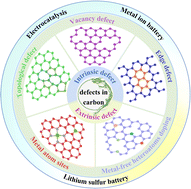Defect engineering in carbon materials for electrochemical energy storage and catalytic conversion
Abstract
Carbon, featured by its distinct physical, chemical, and electronic properties, has been considered a significant functional material for electrochemical energy storage and conversion systems. Significant improvements in the configuration, electron distribution, and chemical environment of the carbon matrix by unavoidable defect sites have hastened parturition in the study of carbon defect engineering which has become a vital research subject in defect chemistry. Compared to pure carbon with natural inertness, the defect-rich carbon matrix can modulate the electronic properties, increase exposed active sites, and further accelerate the electrochemical redox reaction, thus ultimately improving battery performance and electrocatalyst activity. This review covers recent advances in understanding, designing, and exploring defects in carbon materials toward energy-related applications. In particular, the role and active origin of defects have been comprehensively discussed on the basis of both experimental results and theoretical calculations. This article aims to provide reference and guidance for large-scale, diversified, and industrial applications of defect-rich carbon functional materials.

- This article is part of the themed collection: Recent Review Articles


 Please wait while we load your content...
Please wait while we load your content...